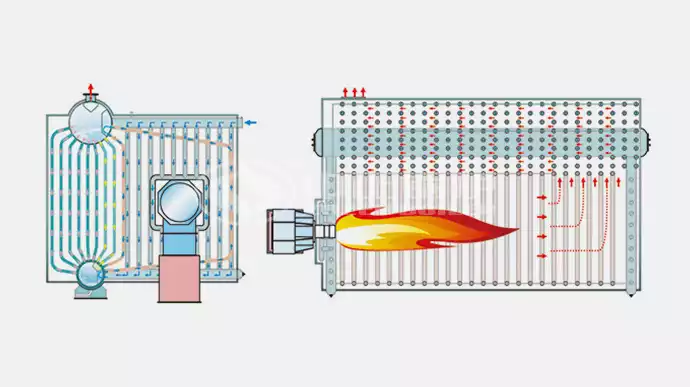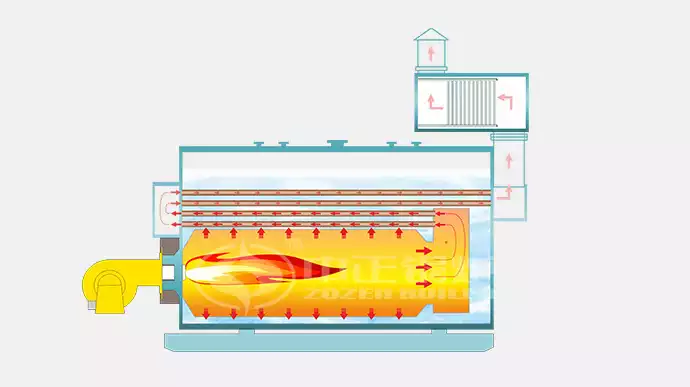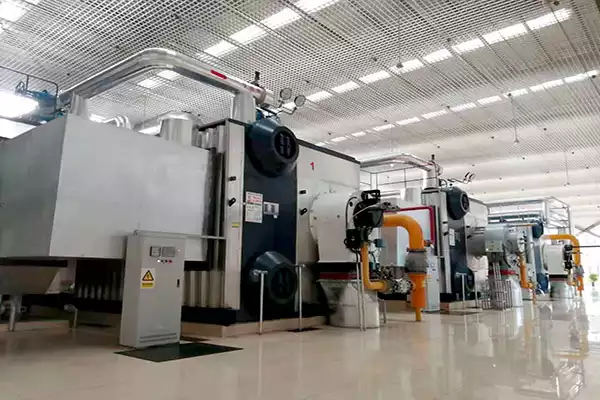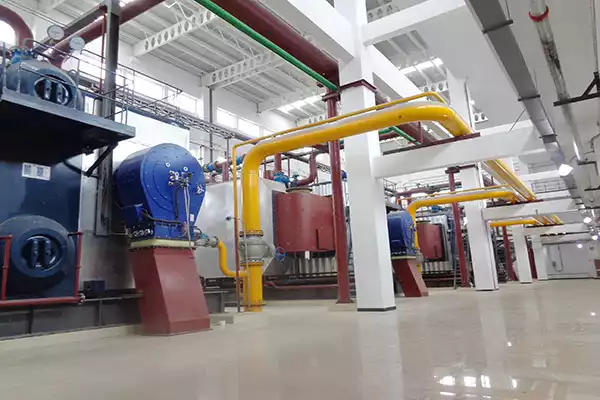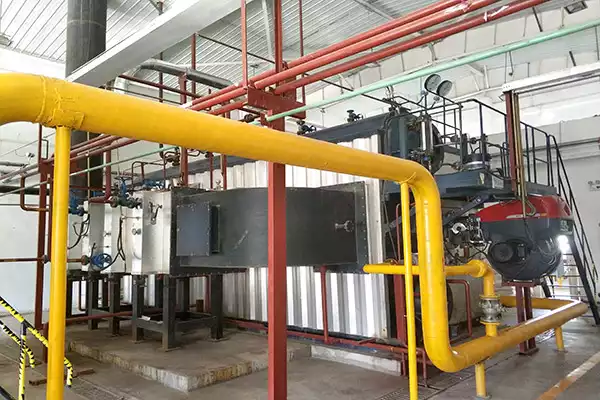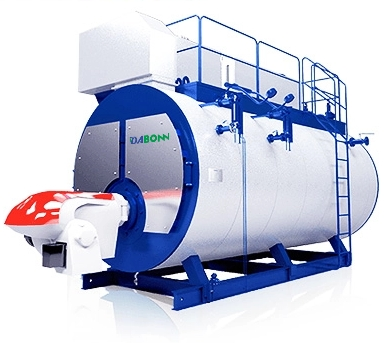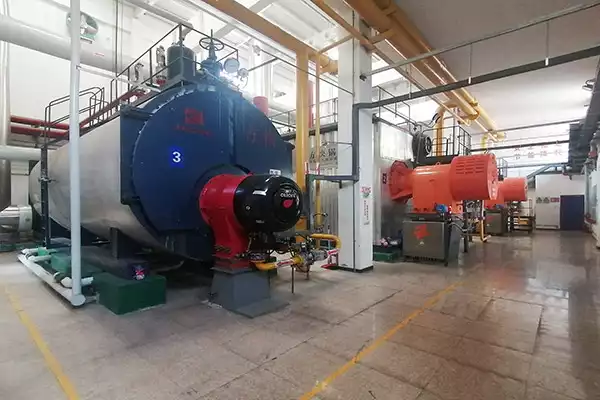
Giới thiệu
In the boiler industry, there are two main types of boilers: water tubes and fire tubes. Both boilers use similar heating techniques but differ in how they operate. If you’re considering purchasing a new boiler or replacing your existing one, understanding these differences can help you make an informed decision that suits your needs. Trong hướng dẫn này, we’ll start by explaining how each type of boiler works. Then we’ll compare their sizes, weights, capacities, and efficiency ratings before wrapping things up with a comparison of their advantages and disadvantages.
What is a Water Tube Boiler?
MỘT water tube boiler refers to a boiler where high-temperature flue gas flows and releases heat outside the pipe, while water absorbs heat inside the pipe. Which water circulates through tubes inside the boiler. The heat that drives the process is transferred indirectly from the furnace to the liquid, which then evaporates and raises its pressure as it changes into steam.
Water tube boilers are used in large power plants, but they’re also found in smaller applications including residential heating systems and individual room furnaces.
What is a Fire Tube Boiler?
Fire tube boilers are also known as shell boilers. There is a large diameter drum, a fire tube, and a large number of thin tubes inside. The smoke generated by the combustion of fuel heats the water, steam, or steam-water mixture outside the smoke pipe, producing hot water. Fire tube boilers can be used for low-pressure steam or superheated steam, depending on the design of their water circulation system.
Main Difference
The furnace of a water tube boiler is placed outside the cylinder, and the volume of the furnace can be large or small, có thể đáp ứng các yêu cầu của quá trình đốt cháy và tăng bay hơi.
Trống của nồi hơi ống nước thường không được làm nóng trực tiếp, và các đường ống chứa hơi nước được đặt trong lò và ống khói làm bề mặt sưởi ấm, cải thiện đáng kể hiệu suất truyền nhiệt và hiệu suất an toàn.
Trong số hai, nồi hơi ống nước có đường kính trống nhỏ hơn, áp lực làm việc cao hơn, công suất nước nhỏ hơn, khả năng thích ứng tốt hơn để thay đổi tải, và hiệu suất nhiệt cao hơn so với nồi hơi ống lửa.
The structure of a fire tube boiler is simple, with a fixed water level, low cost, and easy operation, while the structure of a water tube boiler is complex, requiring an additional dome steam chamber, which is expensive.
Working Principle Comparison
In a water tube boiler, water circulates in a closed circuit. Heat travels from the combustion chamber through the furnace’s tubes, then the water passes through the condenser, where it is cooled back to liquid form before returning to the starting point.
Water Tube Boilers are also known as “single pass” systems because there is only one trip for them through their various components:
- Buồng đốt (làm nóng bằng than hoặc dầu) -> ống -> Bơm tuần hoàn khu vực truyền nhiệt -> Bơm tuần hoàn -> Bồn nước
Nồi hơi ống lửa có thiết kế mạch hở, trong đó khí nóng đi vào ở một đầu của mỗi ống và thoát ra ở đầu kia do chênh lệch áp suất do quạt và tủ hút tạo ra trong chính mỗi ống.
So sánh kích thước
Nồi hơi ống lửa nhỏ hơn nồi hơi ống nước. Nồi hơi ống lửa có thể nhỏ như 32 inch đường kính, trong khi nồi hơi ống nước có thể cần phải lớn bằng 48 inch trong đường kính để đạt được cùng một đầu ra. Điều này làm cho ống cứu hỏa nhỏ gọn hơn và dễ lắp đặt hơn trong không gian chật hẹp.
So sánh trọng lượng
Nồi hơi ống nước thường nặng hơn nồi hơi ống lửa do kích thước lớn, mặc dù điều này phụ thuộc vào kích thước của nồi hơi ống nước. Trọng lượng của nồi hơi ống nước có thể dao động từ 5 tấn để 15 tấn, trong khi nồi hơi ống lửa có xu hướng nhẹ hơn ở khoảng 1 tấn.
So sánh năng lực
Khi nói đến năng lực, nồi hơi ống nước có định mức công suất cao hơn nồi hơi ống lửa. Điều này là do ống nước lớn hơn và hiệu quả hơn ống lửa. Công suất trung bình của nồi hơi ống nước là 1 MW Hoặc nhiều hơn. Hầu hết nồi hơi ống lửa có công suất dưới đây 1 MW.
So sánh hiệu quả
Khi nói đến hiệu quả, nồi hơi ống nước có ưu thế. Nồi hơi ống nước thường có hiệu suất 90% hoặc ở trên, trong khi nồi hơi ống lửa có xu hướng gần hơn với 80% có hiệu quả. Lý do cho sự khác biệt này nằm ở diện tích bề mặt làm nóng và vị trí của các ống trong mỗi thiết kế:
- Các ống nước được đặt bên trong vỏ nồi hơi chứa hơi và nước, có nghĩa là chúng trở nên nóng hơn ống lửa khi tiếp xúc trực tiếp với nhiệt từ khí đốt hoặc than/gỗ hỏa hoạn.
- Các ống lửa được bao quanh bởi không khí lạnh chứ không phải hơi nước ấm hoặc nước nóng, so they don’t transfer as much heat into their surroundings as do their water-filled counterparts (and thus waste more energy).
Advantages Comparison
Advantages of water tube boilers
- Have a better heat transfer rate than fire tube boilers. This means that they can transfer more energy from the fuel to the water, which results in higher efficiency and lower operating costs.
- Have a longer lifespan than fire tube boilers because of their design (they have fewer moving parts).
- Are more efficient at turning fuel into heat and steam than fire tube boilers because they have better thermal conductivity between tubes and boiler walls, allowing for greater surface contact with the water inside them.
Advantages of fire tube boilers
- Better strength. Fire tube boilers have better strength than water tube boilers because the pressure vessel is made of steel and can withstand high temperatures. The pressure vessel of a water tube boiler is made of copper, which cannot withstand as much heat as steel.
- Cheaper to buy. A fire tube boiler costs less money to buy than a water tube boiler because it has fewer parts and materials used in its construction, such as iron pipes instead of copper ones, so there’s less labor involved in making them too!
Disadvantage Comparison
- Water tube boilers are more expensive than fire tube boilers.
- Fire tubes are less efficient than water tubes, which means they use more fuel to produce the same amount of heat or steam. Đây có thể là một vấn đề nếu bạn có nguồn tài nguyên hạn chế và cần bảo tồn chúng càng nhiều càng tốt.
- Sự an toàn của nồi hơi phụ thuộc vào thiết kế của nó. Nhưng nói chung, nồi hơi ống nước an toàn hơn. Bởi vì cấu trúc của chúng ít có khả năng gây nổ hơn so với các thiết kế ống cứu hỏa sử dụng hơi nước cao áp hoặc khí nóng trong hệ thống kín (giống như những thứ được tìm thấy trong các nhà máy điện).
Bộ trao đổi nhiệt So sánh
In a water tube boiler, các bộ trao đổi nhiệt phức tạp hơn. The tubes that transfer heat can be bent into different shapes and the fluid flow is often more turbulent than in fire tube boilers. This makes it possible for a single water tube boiler to have multiple steam drums and superheaters instead of just one or two like you’d find in a fire tube design.
Ngược lại, fire tube boilers have less complex heat exchangers due to their simpler design which calls for straight tubes that carry both fuel gas and combustion air through them (instead of separate pipes). This makes them easier to manufacture but also results in less efficient operation when compared with their cousins–especially when running at higher temperatures or pressures where turbulence becomes important!
Security Comparison
Water tube boilers are more secure than fire tube boilers. Water tube boilers have a tighter seal between the tubes and the shell of the boiler, which means that there’s less chance for steam and water to leak out. Nồi hơi ống lửa cũng có thể nguy hiểm hơn vì nếu một trong các ống khói của bạn bị tắc, nó có thể khiến áp suất bên trong nồi hơi của bạn tăng cao một cách nguy hiểm. Điều này có thể dẫn đến một vụ nổ hoặc thiệt hại khác.
Phần kết luận
Tóm lại là, nồi hơi ống nước và ống lửa đều là những lựa chọn tuyệt vời để sưởi ấm ngôi nhà của bạn. Cả hai đều có ưu và nhược điểm, nhưng nhìn chung chúng tôi nghĩ rằng nồi hơi ống nước là sự lựa chọn tốt hơn. Fangkuai chủ yếu sản xuất các loại nồi hơi ống lửa: nồi hơi tích hợp, nồi hơi tách, nồi hơi ngưng tụ, nồi hơi đốt trong buồng đốt nằm ngang, nồi hơi đốt buồng ống lửa thẳng đứng, vân vân. Có các loại nồi hơi ống nước, chẳng hạn như nồi hơi ống nước thẳng đứng trống đôi, vân vân. Nếu bạn muốn tìm hiểu về thông số chi tiết và giá cả của , Vui lòng liên hệ với chúng tôi tại +0086 186-2391-5479.
Nhận giá tốt nhất của bạn
Nhanh chóng so sánh 3 Báo giá miễn phí
- Kỹ sư báo giá nhanh
- Tốc độ giao hàng tổng thể nhanh chóng
- Lựa chọn tài chính
- Chi phí lắp đặt thấp và tiết kiệm chi phí
25 years+ of boiler R&D
Nhiều hơn 20 Công nghệ sáng tạo
